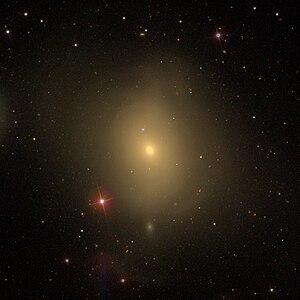Messier 85
| Galaxie Messier 85 | |
|---|---|
 | |
| Die Galaxie Messier 85, Bildausschnitt aus der SDSS | |
| AladinLite | |
| Sternbild | Haar der Berenike |
| Position Äquinoktium: J2000.0, Epoche: J2000.0 | |
| Rektaszension | 12h 25m 24,1s[1] |
| Deklination | +18° 11′ 29″[1] |
| Erscheinungsbild | |
| Morphologischer Typ | SA(s)0+/pec[1] |
| Helligkeit (visuell) | 9,1 mag[2] |
| Helligkeit (B-Band) | 10,0 mag[2] |
| Winkelausdehnung | 7,1′ × 5,5′[2] |
| Positionswinkel | 5°[2] |
| Flächenhelligkeit | 13,0 mag/arcmin²[2] |
| Physikalische Daten | |
| Zugehörigkeit | Virgo-Galaxienhaufen, LGG 292 |
| Rotverschiebung | 0.002432 ± 0.000006[1] |
| Radialgeschwindigkeit | (729 ± 2) km/s[1] |
| Hubbledistanz H0 = 73 km/(s • Mpc) | (50 ± 17) · 106 Lj (15,22 ± 5,3) Mpc [1] |
| Durchmesser | 105.000 Lj |
| Geschichte | |
| Entdeckung | Pierre Méchain |
| Entdeckungsdatum | 4. März 1781 |
| Katalogbezeichnungen | |
| M 85 • NGC 4382 • UGC 7508 • PGC 40515 • CGCG 099-045 • MCG +03-32-029 • VCC 798 • GC 2946 • h 1242 • KCPG 334A | |
Messier 85 (auch als NGC 4382 bezeichnet) ist eine elliptische Galaxie vom Hubble-Typ E-S0 im Sternbild Haar der Berenike. Sie ist schätzungsweise 50 Millionen Lichtjahre von der Milchstraße entfernt, hat einen Scheibendurchmesser von etwa 105.000 Lj und ist Mitglied des Virgo-Galaxienhaufens.
Messier 85 wurde am 4. März 1781 von dem französischen Astronomen Pierre Méchain entdeckt.[3]
Die linsenförmige (Hubble-Typ S0) Galaxie M 85 ist die nördlichste Galaxie des Virgo-Galaxienhaufens. Die Balken-Spiralgalaxie NGC 4394 mit einer Helligkeit von 11,2 mag, die in einer Entfernung von 8 Bogenminuten zu finden ist, scheint ein echter Begleiter von M85 zu sein, denn beide Galaxien weisen dieselbe Rotverschiebung auf, die auf eine Radialgeschwindigkeit von ca. 700 km/s schließen lässt.
Am 20. Dezember 1960 wurde in Messier 85 die Supernova SN 1960R vom Typ Ia entdeckt.[4][5][4]
Literatur
- König, Michael & Binnewies, Stefan (2019): Bildatlas der Galaxien: Die Astrophysik hinter den Astrofotografien, Stuttgart: Kosmos, S. 197
Weblinks
- spektrum.de: Amateuraufnahmen [1]
- The darkness within? (englisch)
- SEDS
- M85 bei SEDS
Einzelnachweise
- ↑ a b c d NASA/IPAC EXTRAGALACTIC DATABASE
- ↑ a b c d e SEDS: NGC 4382
- ↑ Seligman
- ↑ a b Searching NED for object "SN 1960R*". In: NASA/IPAC Extragalactic Database. Abgerufen am 5. Oktober 2008 (englisch).
- ↑ List of Supernovae. HARVARD-SMITHSONIAN CENTER FOR ASTROPHYSICS, abgerufen am 20. März 2008 (englisch).
Auf dieser Seite verwendete Medien
Bildtafel der 110 Messier-Objekte. Diese Datei wird in der w:de:Template:Navigationsleiste Messierobjekte als Imagemap genutzt. Sie darf daher nicht durch eine andere Version überschrieben werden!
Autor/Urheber: Sloan Digital Sky Survey, Lizenz: CC BY 4.0

Angle of view: 12' x 12' (0.3515625" per pixel), north is up.
Details on the image processing pipeline: https://www.sdss.org/dr14/imaging/jpg-images-on-skyserver/(c) ESA/Hubble, CC BY 4.0
The darkness within?
This atmospheric image shows a galaxy named Messier 85, captured in all its delicate, hazy glory by the NASA/ESA Hubble Space Telescope. Messier 85 slants through the constellation of Coma Berenices (Berenice’s Hair), and lies around 50 million light-years from Earth. It was first discovered by Charles Messier’s colleague Pierre Méchain in 1781, and is included in the Messier catalogue of celestial objects.
Messier 85 is intriguing — its properties lie somewhere between those of a lenticular and an elliptical galaxy, and it appears to be interacting with two of its neighbours: the beautiful spiral NGC 4394, located out of frame to the upper left, and the small elliptical MCG 3-32-38, located out of frame to the centre bottom.
The galaxy contains some 400 billion stars, most of which are very old. However, the central region hosts a population of relatively young stars of just a few billion years in age; these stars are thought to have formed in a late burst of star formation, likely triggered as Messier 85 merged with another galaxy over four billion years ago. Messier 85 has a further potentially strange quality. Almost every galaxy is thought to have a supermassive black hole at its centre, but from measurements of the velocities of stars in this galaxy, it is unclear whether Messier 85 contains such a black hole.
This image combines infrared, visible and ultraviolet observations from Hubble’s Wide Field Camera 3.
Credit:
ESA/Hubble & NASA, R. O'Connell
Coordinates Position (RA): 12 25 24.00 Position (Dec): 18° 11' 16.55" Field of view: 2.55 x 2.69 arcminutes Orientation: North is 0.1° right of vertical
Colours & filters Band Wavelength Telescope Optical u 336 nm Hubble Space Telescope WFC3 Optical B 438 nm Hubble Space Telescope WFC3 Optical V 555 nm Hubble Space Telescope WFC3 Optical I 814 nm Hubble Space Telescope WFC3.




